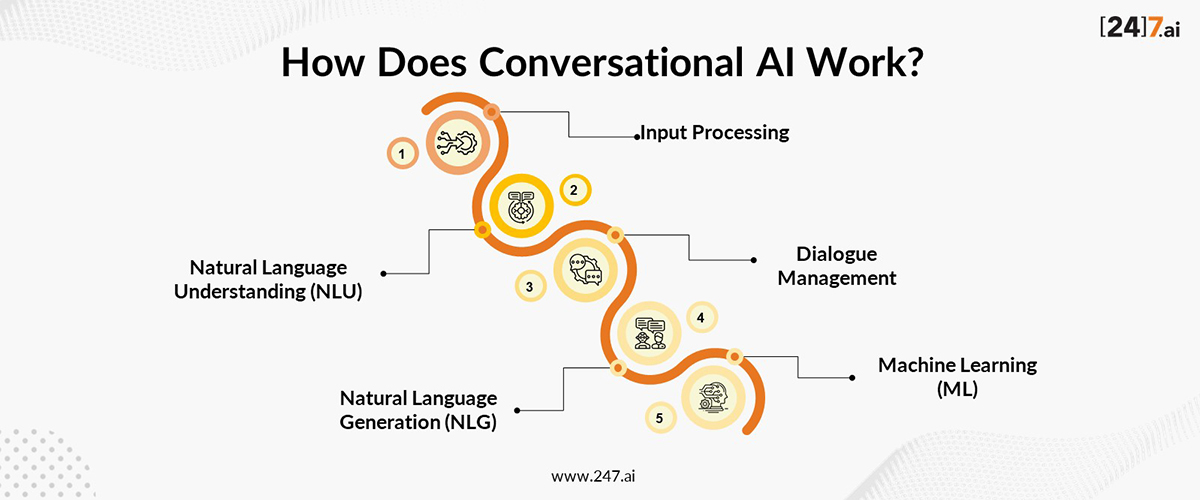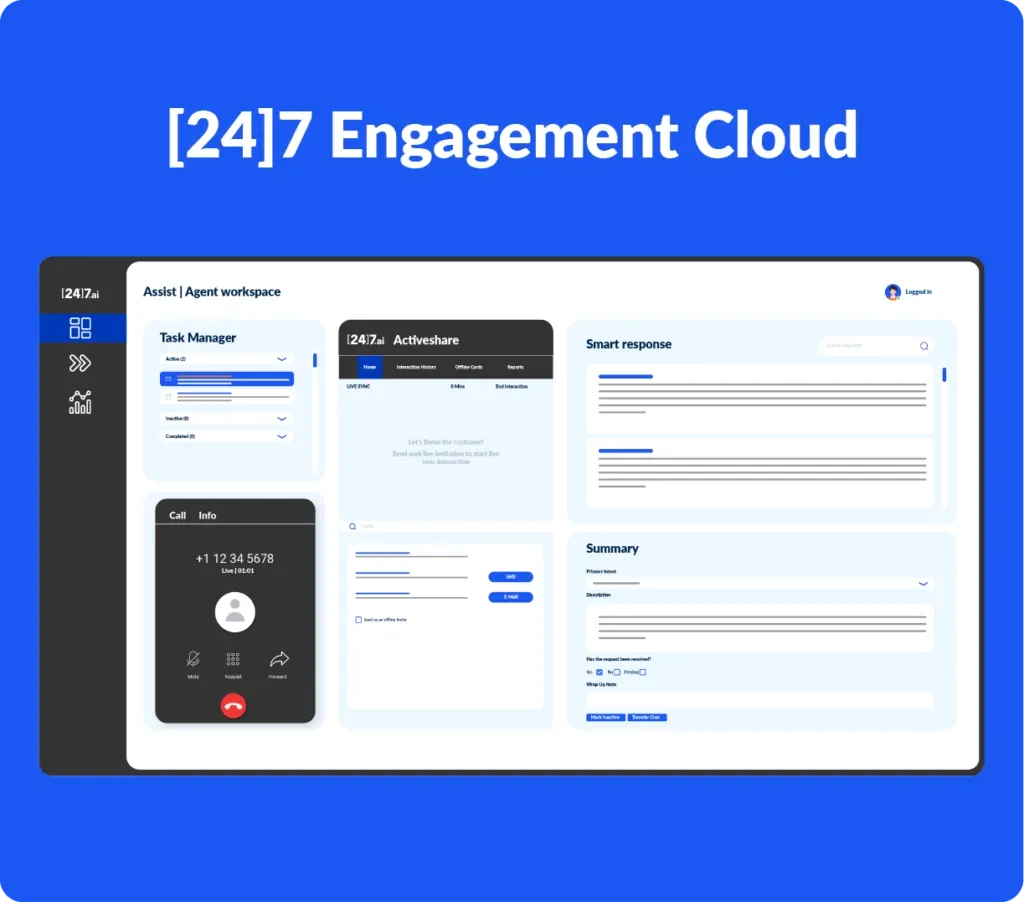As businesses race to meet customer expectations for speed and availability, AI-powered communication is becoming the norm. Reflecting this shift, the global AI chatbot market is expected to grow from US$15.57 billion in 2024 to US$46.64 billion by 2029, a clear sign of how rapidly enterprises are embracing conversational AI to transform engagement at scale.
Conversational AI, delivered via website chatbots, mobile voice assistants, and automated agents on messaging platforms, is fundamentally transforming how enterprises engage with customers, offering intelligent, scalable interactions across every digital touchpoint.
This shift is already well underway. As early as 2020, 56% of companies reported that conversational bots were driving disruption in their industry, emphasizing the transformative power of this technology.
This blog explores what conversational AI is, how it works, its key technologies, types, and real-world business use cases.
What is Conversational AI?
Conversational AI refers to the set of technologies that enable machines to understand, process, and respond to human language in a natural, conversational manner. It powers automated systems such as chatbots, voice assistants, and virtual agents, enabling them to simulate real human conversation.
Unlike rule-based bots that rely on scripted flows, conversational AI uses natural language processing (NLP), machine learning (ML), and dialogue management to deliver personalized responses.

How Does Conversational AI Work?
Conversational AI systems follow a multi-step process to interact intelligently:
- Input Processing: The system first captures user input through voice or text. Advanced solutions also support multilingual inputs and detect sentiment or urgency through tone or word choice.
- Natural Language Understanding (NLU): This is the brain of the system. NLU breaks down the input to understand intent, entities, and context, moving beyond keyword matching to grasp true user meaning, even with colloquial language or slang.
- Dialogue Management: Based on the interpreted intent and context, the system selects the next step in the conversation. This could involve fetching data, asking a clarifying question, or triggering a process (such as checking order status or resetting a password).
- Natural Language Generation (NLG): The response is then composed in clear, conversational language that matches the user’s tone, channel, and intent, ensuring the interaction feels natural and consistent.
- Machine Learning: Over time, the system refines its accuracy by learning from user interactions, feedback loops, and ongoing data training, becoming more intelligent, responsive, and predictive.
The goal is to make every interaction feel effortless, personalized, and relevant at scale.

Core Applications and Deployment Models of Conversational AI
Conversational AI isn’t limited to one format. It powers a range of applications, such as:
- Chatbots: Often embedded in websites and mobile apps, these handle high-volume, repetitive queries such as order tracking or FAQs. Modern chatbots are context-aware and can personalize interactions based on previous conversations.
- Voice Assistants: Integrated into mobile apps, call centers, or smart speakers, voice-based AI allows users to speak naturally to complete tasks hands-free. These systems are ideal for accessibility, on-the-go use, and industries such as telecom and travel.
- Virtual Agents: These go beyond basic scripts, managing complex, multi-turn dialogues across processes such as insurance claims, financial advising, or tech troubleshooting. They can engage users through multiple channels and make real-time decisions based on input.
- Messaging Bots: Operating on platforms such as WhatsApp, Facebook Messenger, or SMS, these bots are particularly effective for proactive outreach, transactional updates, and customer support in industries with high mobile engagement.
Each type serves different business functions, from answering FAQs to booking appointments or solving technical issues.

Cross-Industry Use Cases and Deployment Scenarios
Conversational AI is being implemented across industries to improve service and reduce costs:
- Retail & eCommerce: Automating product recommendations based on browsing history, enabling real-time order tracking, and handling return logistics, all without human intervention.
- Banking & Financial Services: Managing routine tasks such as balance checks, enabling secure two-factor verifications, processing loan applications, and addressing compliance-related queries through intelligent routing.
- Healthcare: Scheduling appointments, sending post-care instructions, guiding patients through symptom checkers, and even answering insurance-related questions, while ensuring HIPAA-compliant data handling.
- Travel & Hospitality: Helping travelers modify itineraries, get real-time flight updates, and receive localized recommendations, especially useful in international or critical travel scenarios.
- Telecom: Streamlining technical issue diagnostics, upgrading plans, and providing multilingual support across channels, reducing load on live agents while enhancing CSAT scores.

Critical Features of Scalable Conversational AI Platforms
For enterprises, not all conversational AI platforms are equal. The most effective solutions include:
- Omnichannel Delivery: Interact across web, mobile, messaging, and voice
- AI + Human Handoff: Complete escalation to live agents when needed
- Personalization: Tailored interactions based on past behavior and context
- Scalability: Ability to support millions of conversations simultaneously
- Compliance & Security: Especially critical in finance, healthcare, and government sectors
How [24]7.ai Powers Enterprise Conversational AI
By merging advanced conversational AI with deep contact center expertise, [24]7.ai delivers intelligent, scalable customer experiences that drive efficiency and engagement. Through [24]7 Conversations, our AI platform understands intent, manages context, and enables complete handoffs between bots and agents.
Paired with [24]7 Agent Services, it ensures every interaction is fast, human-centric, and optimized for impact.
At [24]7.ai, we help global enterprises build conversational experiences that are intelligent, human-like, and scalable. From first contact to final resolution, our technology ensures every interaction feels effortless.
Ready to transform your customer experience with the power of Conversational AI?
Frequently Asked Questions
Yes. Platforms built for enterprise-grade conversational AI easily integrate with CRMs and backend data systems to pull in customer context and deliver intelligent, personalized responses.
Finance, retail, telecom, healthcare, travel, and education are leading adopters, but virtually every customer-facing sector can benefit.
Many fall short due to poor system integration, lack of training data, inconsistent customer experiences, and challenges in maintaining privacy and compliance across channels.
Absolutely. Advanced platforms can handle multiple languages and dialects to serve diverse global audiences.
Enterprises often report reduced support costs, improved CSAT, and increased conversion rates within months of deployment.



